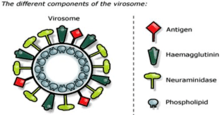Virosome

A virosome is a drug or vaccine delivery mechanism consisting of unilamellar phospholipid membrane (either a mono- or bi-layer) vesicle incorporating virus derived proteins to allow the virosomes to fuse with target cells. As a drug or vaccine delivery mechanism they are biologically compatible with many host organisms and are also biodegradable. The use of reconstituted virally derived proteins in the formation of the virosome allows for the utilization of what would otherwise be the immunogenic properties of a live-attenuated virus, but is instead a safely killed virus. [1]
Influenza virosomes
In contrast to liposomes, virosomes contain functional viral envelope glycoproteins: influenza virus hemagglutinin (HA) and neuraminidase (NA) intercalated in the phospholipid bilayer membrane. They have a typical mean diameter of 150 nm. Essentially, virosomes represent reconstituted empty influenza virus envelopes, devoid of the nucleocapsid including the genetic material of the source virus.[2]
The unique properties of virosomes partially relate to the presence of biologically active influenza HA in their membrane. This viral protein not only confers structural stability and homogeneity to virosome-based formulations, but it significantly contributes to the immunological properties of virosomes, which are clearly distinct from other liposomal and proteoliposomal carrier systems. It has been shown that a physical association between the virosome and the antigen of interest is necessary for the full adjuvant effect of virosomes. Such physical association can be achieved by a variety of methods, depending on the properties of the antigen. Antigens can be incorporated into virosomes, adsorbed to the virosome surface, or integrated into the lipid membrane, either via hydrophobic domains or lipid moieties cross-linked to the antigen.
Virosomes therefore represent an innovative, broadly applicable adjuvant and carrier system with prospective applications in areas beyond conventional vaccines. They are one of only three adjuvant systems widely approved by regulatory authorities and the only one that has carrier capabilities.
Non-influenza virosomes
They are also being considered for HIV-1 vaccine research.[3]
They were used as a drug carrier mechanism for experimental cancer therapies.[4]
References
- ↑ Kapoor, D.; Vyas, R. B.; Lad, C.; Patel, M. (2013-09-14). "A MULTIPURPOSE AND NOVEL CARRIER FOR DRUG DELIVERY AND TARGETING - VIROSOMES". Journal of Drug Delivery and Therapeutics. 3 (5): 143–147. doi:10.22270/jddt.v3i5.627. ISSN 2250-1177.
- ↑ hHuckriede, Anke; Bungener, Laura; Stegmann, Toon; Daemen, Toos; Medema, Jeroen; Palache, Abraham M.; Wilschut, Jan (2005). "The virosome concept for influenza vaccines". Vaccine. 23: S26–38. doi:10.1016/j.vaccine.2005.04.026. PMID 16026906.
- ↑ http://ec.europa.eu/research/health/infectious-diseases/poverty-diseases/projects/90_en.htm HIV VIROSOMES.
- ↑ Waelti, Ernst; Wegmann, Nina; Schwaninger, Ruth; Wetterwald, Antionette; Wingenfeld, Carsten; Rothen-Rutishauser, Barbara; Gimmi, Claude D. (2002). "Targeting her-2/neu with antirat Neu virosomes for cancer therapy". Cancer Research. 62 (2): 437–44. PMID 11809693.